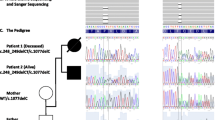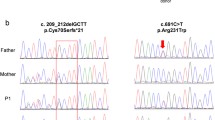Abstract
Epidermodysplasia verruciformis (EV) is a rare genodermatosis characterized by persistent flat warts or pityriasis versicolor-like lesions caused by betapapillomaviruses (EV-HPVs). Autosomal recessive EVER1 and EVER2 deficiencies account for EV in most patients. The mechanisms by which mutations in these partners of the Zinc transporter ZnT1 impair host defense against EV-HPVs are still poorly understood. Keratinocytes of EVER-deficient patients display an alteration of zinc homeostasis and an enhanced proliferative activity. Since EVER proteins are highly expressed in T lymphocytes, we aimed to assess the impact of EVER2 deficiency on T-cell development and function. We studied circulating lymphocyte populations in three adult EV patients sharing the same EVER2 mutation (T150fsX3). We found a normal count of CD4+ and CD8+ T cells and a normal proliferative capacity in response to anti-CD3 stimulation. However, we observed a significant increase of memory CD4+ and effector memory CD8+ T cells, a bias of the TCR Vαβ and Vγδ repertoires and an increase of skin-homing CD4+ T-cell subsets. Our findings suggest that EVER2-deficient patients display mild T-cell abnormalities. It remains unclear whether these abnormalities result from EVER deficiency, chronic EV-HPV infection, or both.


Similar content being viewed by others
References
Orth G. Host defenses against human papillomaviruses: lessons from epidermodysplasia verruciformis. Curr Top Microbiol Immunol. 2008;321:59–83.
Lutzner MA. Epidermodysplasia verruciformis. An autosomal recessive disease characterized by viral warts and skin cancer. A model for viral oncogenesis. Bull Cancer. 1978;65(2):169–82.
Orth G. Genetics of epidermodysplasia verruciformis: Insights into host defense against papillomaviruses. Semin Immunol. 2006;18(6):362–74.
Prawer SE, Pass F, Vance JC, Greenberg LJ, Yunis EJ, Zelickson AS. Depressed immune function in epidermodysplasia verruciformis. Arch Dermatol. 1977;113(4):495–9.
Glinski W, Jablonska S, Langner A, Obalek S, Haftek M, Proniewska M. Cell-mediated immunity in epidermodysplasia verruciformis. Dermatologica. 1976;153(4):218–27.
Glinski W, Obalek S, Jablonska S, Orth G. T cell defect in patients with epidermodysplasia verruciformis due to human papillomavirus type 3 and 5. Dermatologica. 1981;162(3):141–7.
Majewski S, Skopinska-Rozewska E, Jablonska S, Wasik M, Misiewicz J, Orth G. Partial defects of cell-mediated immunity in patients with epidermodysplasia verruciformis. J Am Acad Dermatol. 1986;15(5 Pt 1):966–73.
Pereira de Oliveira WR, Carrasco S, Neto CF, Rady P, Tyring SK. Nonspecific cell-mediated immunity in patients with epidermodysplasia verruciformis. J Dermatol. 2003;30(3):203–9.
Majewski S, Malejczyk J, Jablonska S, Misiewicz J, Rudnicka L, Obalek S, et al. Natural cell-mediated cytotoxicity against various target cells in patients with epidermodysplasia verruciformis. J Am Acad Dermatol. 1990;22(3):423–7.
Kaminski M, Pawinska M, Jablonska S, Szmurlo A, Majewski S, Orth G. Increased natural killer cell activity in patients with epidermodysplasia verruciformis. Arch Dermatol. 1985;121(1):84–6.
Ramoz N, Rueda LA, Bouadjar B, Montoya LS, Orth G, Favre M. Mutations in two adjacent novel genes are associated with epidermodysplasia verruciformis. Nat Genet. 2002;32(4):579–81.
Casanova JL, Abel L. Primary immunodeficiencies: a field in its infancy. Science. 2007;317(5838):617–9.
Alcais A, Quintana-Murci L, Thaler DS, Schurr E, Abel L, Casanova JL. Life-threatening infectious diseases of childhood: single-gene inborn errors of immunity? Ann N Y Acad Sci. 2010;1214:18–33.
Lazarczyk M, Pons C, Mendoza JA, Cassonnet P, Jacob Y, Favre M. Regulation of cellular zinc balance as a potential mechanism of EVER-mediated protection against pathogenesis by cutaneous oncogenic human papillomaviruses. J Exp Med. 2008;205(1):35–42.
Landini MM, Zavattaro E, Borgogna C, Azzimonti B, De Andrea M, Colombo E, et al. Lack of EVER2 protein in two epidermodysplasia verruciformis patients with skin cancer presenting previously unreported homozygous genetic deletions in the EVER2 gene. J Invest Dermatol. 2012;132(4):1305–8.
Keresztes G, Mutai H, Heller S. TMC and EVER genes belong to a larger novel family, the TMC gene family encoding transmembrane proteins. BMC Genomics. 2003;4(1):24.
Haase H, Rink L. Functional significance of zinc-related signaling pathways in immune cells. Annu Rev Nutr. 2009;29:133–52.
Yu M, Lee WW, Tomar D, Pryshchep S, Czesnikiewicz-Guzik M, Lamar DL, et al. Regulation of T cell receptor signaling by activation-induced zinc influx. J Exp Med. 2011;208(4):775–85.
Lazarczyk M, Dalard C, Hayder M, Dupre L, Pignolet B, Majewski S, et al. EVER proteins, key elements of the natural anti-human papillomavirus barrier, are regulated upon T-cell activation. PLoS One. 2012;7(6):e39995.
Crequer A, Troeger A, Patin E, Ma CS, Picard C, Pedergnagna V, et al. Human RHOH deficiency causes T cell defects and susceptibility to EV-HPV infections. J Clin Invest. 2012;In press.
Crequer A, Picard C, Patin E, D'Amico A, Abhyankar A, Munzer M, Debre M, de Saint-Basile G, Fischer A, Abel L, Orth G, Casanova J.-L., Jouanguy E. Inherited MST1 deficiency underlies susceptibility to EV-HPV infections. In revision Plos one. 2012;In press.
Jablonska S, Dabrowski J, Jakubowicz K. Epidermodysplasia verruciformis as a model in studies on the role of papovaviruses in oncogenesis. Cancer Res. 1972;32(3):583–9.
Clark RA, Chong B, Mirchandani N, Brinster NK, Yamanaka K, Dowgiert RK, et al. The vast majority of CLA + T cells are resident in normal skin. J Immunol. 2006;176(7):4431–9.
Nestle FO, Di Meglio P, Qin JZ, Nickoloff BJ. Skin immune sentinels in health and disease. Nat Rev Immunol. 2009;9(10):679–91.
Pauls K, Schon M, Kubitza RC, Homey B, Wiesenborn A, Lehmann P, et al. Role of integrin alphaE(CD103)beta7 for tissue-specific epidermal localization of CD8+ T lymphocytes. J Invest Dermatol. 2001;117(3):569–75.
Aochi S, Nakanishi G, Suzuki N, Setsu N, Suzuki D, Aya K, et al. A novel homozygous mutation of the EVER1/TMC6 gene in a Japanese patient with epidermodysplasia verruciformis. Br J Dermatol. 2007;157(6):1265–6.
Nehme NT, Pachlopnik Schmid J, Debeurme F, Andre-Schmutz I, Lim A, Nitschke P, et al. MST1 mutations in autosomal recessive primary immunodeficiency characterized by defective naive T cells survival. Blood. 2011.
Abdollahpour H, Appaswamy G, Kotlarz D, Diestelhorst J, Beier R, Schaffer AA, et al. The phenotype of human STK4 deficiency. Blood. 2012.
Wherry EJ. T cell exhaustion. Nat Immunol. 2011;12(6):492–9.
Randall KL, Chan SS, Ma CS, Fung I, Mei Y, Yabas M, et al. DOCK8 deficiency impairs CD8 T cell survival and function in humans and mice. J Exp Med. 2011;208(11):2305–20.
Soler D, Humphreys TL, Spinola SM, Campbell JJ. CCR4 versus CCR10 in human cutaneous TH lymphocyte trafficking. Blood. 2003;101(5):1677–82.
Acknowledgments
We thank the members of both branches of the Saint Giles Laboratory of Human Genetics of Infectious Diseases, but also Aminata Diabate, Corinne Jacques, Chantal Harre and Stephanie N’Daga for excellent technical assistance, and Svetlana Mazel for flow cytometry expertise. We warmly thank the patients for their participation. This work was supported by grants from INSERM, University Paris Descartes, the Rockefeller University, the St. Giles Foundation, and the Rockefeller University Center for Clinical and Translational Science grant number UL1RR024143.
Competing interest statement
The authors declare that they have no competing financial interests.
Author information
Authors and Affiliations
Corresponding author
Additional information
Amandine Crequer and Capucine Picard contributed equally to this work.
Electronic supplementary materials
Below is the link to the electronic supplementary material.
Esm 1
EVER2-deficient patients have an increase of CCR10+CD4+ T cells. Skin-homing T-cell subsets were assessed on live CD3+-gated cryopreserved PBMCs from the two patients (P1 values indicated by gray diamonds, P2 values indicated by gray squares, P3 values indicated by gray up triangles) and healthy controls (indicated by black circles) by flow cytometry (a) CCR6+, (b) CCR4+ and (c) CCR10+ proportions were assessed on live CD3+, CD4+ and CD8+ gated PBMCs for the patients and 17, 12 and 12 healthy controls, respectively. (* = p <0.05; ns = non significant). (JPEG 50 kb)
Esm 2
EVER2-deficient patients have normal frequencies of αE+, α4+ and β7+ T cells. Tissue-homing T-cell subsets were assessed on live CD3+-gated cryopreserved PBMCs from the two patients (P1 values indicated by gray diamonds, P2 values indicated by gray squares, P3 values indicated by gray up triangles) and healthy controls (indicated by black circles) by flow cytometry (a) αE+, (b) αE+CLA+ proportions were assessed on live CD3+, CD4+ and CD8+ gated PBMCs and 12, 17 and 12 healthy controls, respectively (c) α4+, β7+ and α4+β7+ proportions were assessed on live CD3+ gated PBMCs for the patients and 12 healthy controls, respectively. ns = non significant). (JPEG 52 kb)
Rights and permissions
About this article
Cite this article
Crequer, A., Picard, C., Pedergnana, V. et al. EVER2 Deficiency is Associated with Mild T-cell Abnormalities. J Clin Immunol 33, 14–21 (2013). https://doi.org/10.1007/s10875-012-9749-1
Received:
Accepted:
Published:
Issue Date:
DOI: https://doi.org/10.1007/s10875-012-9749-1




